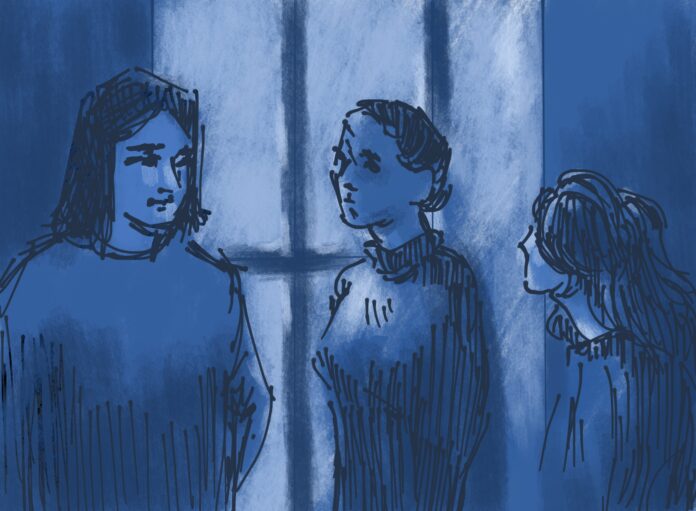The Ficus Religiosa, a tree native to the Indian subcontinent, has an unusual and predatory lifestyle. Its seeds, contained in bird droppings, fall on surrounding trees and produce aerial roots that rise up and strangle the host organism, leaving the unrivaled fig to stand alone.
Mohammad Rasoulof’s 2024 Farsi film “The Seed of the Sacred Fig” subtly places the Iranian government in the position of the Ficus Religiosa, with their theocratic ideals and misogynistic practices serving as the roots that grant them uncontested authority to strangle and kill their citizens. The film was screened at the Kimball Theatre in Colonial Williamsburg as part of the city’s annual Ampersand International Arts Festival.
Filming of “The Seed of the Sacred Fig,” which spanned approximately 70 days, was conducted in secret to avoid persecution by the Iranian government. However, upon its release, Rasoulof was labeled a fugitive and sentenced to eight years in prison. He has since fled the country, leaving behind his work’s powerful commentary about the dangers of authoritarian regimes.
The film opens with Iman, a hard-working husband and father of two, accepting a new position in the Iranian government as an investigator on the path to becoming a judge in Iran’s Revolutionary Court. Upon his promotion, he is given a gun that he stores in his bedside table despite objections from his wife, Najmeh. He then assures his family that, if they follow a set of strict rules, they will soon enjoy a lavish lifestyle, one with individual bedrooms and neighborhoods filled with people who resemble them. However, disappointment soon follows his excitement after he learns he is expected to blindly sign the death certificates of Iranian prisoners without reading the case evidence or establishing proper cause.
While Iman struggles with his moral dilemma, political protests flood the streets of Tehran, leaving mass death and destruction in their wake. The murder of 22-year-old Mahsa Amini at the hands of Iranian police sparked the “Women, Life, Freedom” movement in 2022, which quickly gained political and social traction. Spearheaded by young women, the movement demanded an end to the mandatory hijab laws, the release of imprisoned human rights activists and an end to gender-based violence and discrimination. In response to the unrest, the Iranian government increased unjust detainments, beatings and killings. Rasoulof uses real footage taken by witnesses of this destruction to capture the truly horrific nature of the violence. Shaky iPhone videos of fires ravaging buildings and graphic photos of bodies littering the streets allow the audience to fully comprehend the offenses perpetuated by the Iranian government.
Watching these protests erupt through Instagram reel videos on their iPhones, Iman’s daughters, Rezvan and Sana begin to align themselves with the revolutionary messages. After cleaning the wounds of their friend Sadaf, who was shot in the face during a protest, they challenge their father’s steadfast devotion to the Iranian government and question how he can defend the hostile acts of the police, who are murdering innocent people. Iman claims that his daughters have been brainwashed by propaganda produced by foreign enemies, yet fails to elaborate further on who these elusive enemies are. When his gun suddenly goes missing after this argument, he immediately suspects one of his daughters and soon becomes convinced that his entire family is lying to him.
As his paranoia grows, Iman sends his family to a psychoanalyst who can supposedly uncover which one of them is lying, but in reality is just another investigator in disguise. Ultimately, his plan fails, and he is left with a broken family whose members no longer respect or trust their father. We then learn that Iman’s contact information has been leaked to the public, who are aware of his brutal malpractices at work and therefore pose a large threat to him and his family. Because of this, he decides to take his family out of Tehran toward “safety.” There, still receiving no confession as to who took his gun, he locks Najmeh and Rezvan in separate cellars to condemn them for their disobedience to his authority. In the pivotal culminating scene, Sana, having freed her mother and sister, fires the stolen gun at the ground beneath her father’s feet, causing him to fall to his death. The final shot of Iman’s body buried deep in sand, with only his hand visible, demonstrates how the Iranian government can take a once happy and loving family and pit them against each other.
Rasoulof’s film elicits a strong emotional response from all audience members, but is especially powerful for young women whose lives are controlled by an all-consuming, overarching patriarchy. Rasoulof’s use of videos of women burning their hijabs in the streets of Iran and refusing to surrender to the police creates a unifying urgency among women to finally fight for their individual liberties and abandon their second class citizenry. As we continue to live in a world where Iranian women face life-threatening oppression at the hands of an abusive and misogynistic government devoted to enhancing this suffocating system, it is daringly unapologetic portrayals of the situation in Iran like Rasoulof’s that help draw global attention to these injustices. “The Seed of the Sacred Fig” is therefore an absolute must-watch film for any students concerned with the roots of rebellion and the fight for equality and justice.

